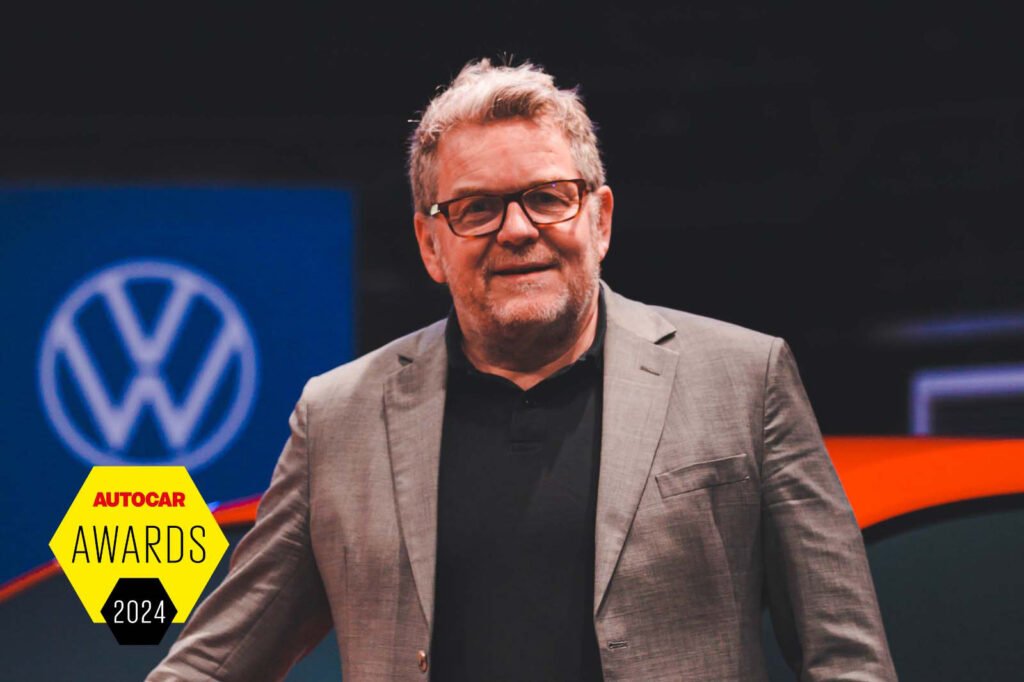
VW’s design boss relishes the challenge of renewing the brand. We learn what’s in his ‘secret sauce’
In June 1993, Autocar asked a group of students from Coventry University’s School of Transport Design to propose a modern reinterpretation of the Caterham Seven.
Exactly 31 years later, one of the students – a German, then on exchange from the Pforzheim University School of Design – is back at Autocar for his efforts to breathe new life into an existing car brand.
Only this time it’s not a hypothetical exercise: Andreas Mindt is now head of design at Volkswagen and he has been tasked with breathing new life into one of the world’s biggest car brands.
When he returned to Wolfsburg in February last year, he had just a few weeks to write the ID 2all, a model that beautifully combines modern design with retro accents – and it was incredibly well received.
The concept was cheerful, friendly and infectiously enthusiastic, just like the man who led the design.
Most importantly, the ID 2all – and Volkswagen boss Thomas Schäfer’s new ‘love brand’ concept – served as a major course correction after years of somewhat anonymous electric ID models, with an approach that saw the manufacturer embrace its traditions without being stuck in the past.
This immediate impact that Mindt had upon his return to Volkswagen is why we named him our Design Hero for 2024.
Mindt joined the Volkswagen Group in 1996, shortly after graduating, and worked on the first generation Tiguan and the legendary Golf Mk7.
In 2014, he moved to Audi, where he designed a range of cars including the A1, the E-tron GT and the AI:ME concept, reminiscent of the A2. In 2021, he moved to Bentley, where his design for the limited-edition Batur helped set the direction for the brand’s future electric vehicles.
Bentley’s return to Volkswagen came about suddenly, when Mindt received a phone call from Schäfer and the new VW group boss Oliver Blume.
“In December (2022), there was a meeting with the CEO and some board members, and I gave a small presentation to explain what I would do with Volkswagen,” says Mindt.
“Large parts of that are still in what we do now. There was a match with the brand: I grew up in Wolfsburg and have it in my blood. I know exactly what to do with Volkswagen. It sounds a bit confident, but I really believe there is a certain way to do it.”
When Mindt says he grew up in Wolfsburg, he means it: his father was a designer for Volkswagen (“so I learned at an early age that a job like this existed”), and his parents had a Beetle. “There were four of us, and we all sat in the back, without seat belts,” he remembers.
“It was yellow, I still remember the license plate and the smell and the sound.” Mindt learned to drive in a diesel Golf (“if you let out the clutch too early, the engine would stall; it was the hardest car to learn in”), and bought himself a Beetle as his first car for 500 Deutsche Marks.
“It was the cheapest car you could get,” he says. Mindt still owns a 1970 version.
So when Mindt was given just six weeks to design a concept for a small electric VW, but within significant constraints (it had to sit on the undercarriage of the much-maligned ID Life concept), he had already been working on it for decades thought.
“I started my job in February,” he says, “and we had the presentation in mid-March. I had to start running; it jumped into the water regardless of the temperature.
The pressure was high: I had to move from England to Germany, so I had to leave that to others. I’m still missing some things! My only focus in those six weeks was to translate our new strategy into this product.
“With just six weeks, it had to be a flawless process. If you make one mistake, it’s in the car. It’s crazy pressure: this was a starting point for Volkswagen. And now we’re going through the portfolio and connecting this to that.”
Mindt admits it’s “a bit strange” for an automaker to start a design refresh with a small model, but he says the approach fits with the “people’s car” heritage that stretches back to VW’s origins.
“The Beetle is a very optimistic, cheerful-looking and friendly car,” he adds.
“It’s not people-eating, you know: other cars are trying to eat everything, like eating the street or something. Volkswagen isn’t about that, it’s not all super duper; it’s the friendliest in the room.
“If you’re a volume maker, you don’t want to be polarizing and most people want to look confident and happy. Not cute or comical, like a Mickey Mouse car, but optimistic and happy. That’s what people want, not aggressive.”
The ID 2all was followed last year by a sporty ID GTI variant, which further strengthened VW’s future design language and showed how the performance sub-brand will be reinvented for the modern era.
“We created the ID GTI to further explain the Volkswagen brand,” says Mindt. “It has to be two things: stable and sympathetic.
And the third is the secret sauce: the special, unexpected, inspiring things we had to add. The first two are homework and can be seen in ID 2. The third was not so easy to understand: what do we mean by secret sauce?
“To explain that we did the GTI concept. There’s a lot of secret sauce on it. For example, it has a good stance, which makes it look safe and stable, but also very sporty, as if you want to take turns with it like a go-kart. With the GTI we have stepped up everything so that you really understand what we mean.”
The GTI concept is full of small design elements, although Mindt says it’s the “strong basic architecture” that forms the “big building blocks” of a car design. “It always comes first and you feel it, but few people talk about it,” he says. “If you have a sleek body and wide axles, it looks really good.”
Those small details help convince purists that Volkswagen is connecting with its past, but they must have a function, says Mindt, “otherwise it is just a decorative element – and we don’t want to do decoration anymore.” He points to the hubcaps with the textured ‘golf ball’ pattern that resembles the gear knob on manual GTI cars.
Mindt and its design team will not only rely on signals from the past: they are currently working on 49 model lines and 150 different models.
“That’s a bit crazy,” he admits. “It’s really a lot.” While many of these models will use shared platforms, VW is starting to move away from its previous strategy of global models and designs toward more region-specific cars, especially in North America and tech-focused China.
The best example is the ID Code concept unveiled at this year’s Beijing Auto Show. It features design elements that will also appear on future European models, but is more tailored to China.
“We have to create a design for Volkswagen worldwide, and then we develop certain elements for each region and also certain sizes of cars,” says Mindt.
“A hot hatch fits perfectly in Europe, but plays a subordinate role in North America and China.
In China they are very interested in lighting elements and they want to show the sensors around the car in a way that you wouldn’t do in Europe.”
Mindt’s first appearance in Autocar in 1993 came from designing a bold new concept. He still owns five copies of that issue and cheerfully notes that we put his idea on the opening page, while his friend Klaus Busse – now Maserati’s design chief – was relegated to the last page.
This time, Mindt’s ideas are of course becoming reality: later this year the production version of the ID 2all will be on display, followed by a crossover on the same MEB Entry platform and finally the production version of the ID GTI.
Mindt says this will be close to the concept and he is confident that all three models will be full of Volkswagen’s ‘secret sauce’.
Given his enthusiasm and passion, it feels like that secret sauce is also flowing through Mindt himself. Volkswagen’s design future is certainly in safe hands.

